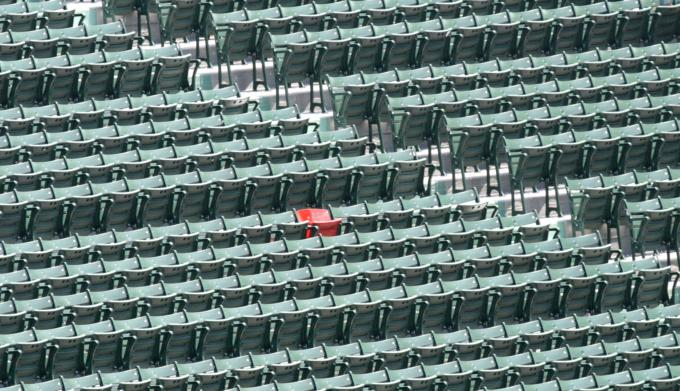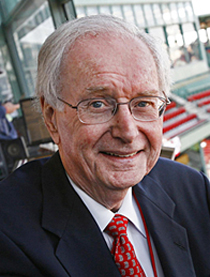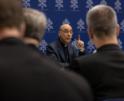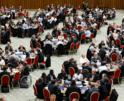
Culture
The bleacher seats (in those days they really were bleachers -- rows of benches) were already crowded by the time that Joe made his way there, but he eventually found a spot to sit in the 33rd row. It was far, far away from the action, but at least he was in the park, the only place in those pre-television days where you could actually see the action.

Flavin
Late in the afternoon of Saturday, June 8, 1946, Boston was struck by a violent thunderstorm. Winds raged at 80 miles an hour, and in one four-minute period a half inch of rain deluged the city. As night fell, there were lightning bolts that came so often and so vividly that it was as if "night turned into day." Trees were uprooted, telephone poles were knocked down, and widespread power outages were reported. It was said to have been one of the worst storms of its kind the city had seen in 60 years. Fortunately, the Red Sox game with the Detroit Tigers that afternoon was already over by the time the blast of bad weather hit.
By the next day, the fast-moving storm had blown out to sea, leaving in its wake significant property damage and many power outages, including rapid transit service to Kenmore Square, just down the street from Fenway Park. Restoration of power was greatly hindered by continuing high winds; they were no longer blowing at 80 MPH, as they had during the height of the early summer storm, but were still howling at nearly gale force. The Red Sox thought briefly about postponing their scheduled doubleheader against the Tigers, but only briefly. Detroit was the defending World Series champion and a sell-out crowd was anticipated. It was back in the days when gate receipts were a team's major source of revenue, so the games would be played despite the windy conditions.
The Boston Globe reported that "A rare and brisk northwest breeze made Yawkey Yard a home run heaven for southpaw clouters." And so it was.
Standing in the long line at the Red Sox box office that Sunday was Joe Boucher, 56 years old, a construction engineer from Albany, New York, and an avid baseball fan. By the time he reached the front of the line every seat in the grandstand had been sold, so Joe did the next best thing. He bought a ticket to the bleachers. The bleacher seats (in those days they really were bleachers -- rows of benches) were already crowded by the time that Joe made his way there, but he eventually found a spot to sit in the 33rd row. It was far, far away from the action, but at least he was in the park, the only place in those pre-television days where you could actually see the action.
The Sox took the opener by a seven to one score, and in the nightcap Ted Williams, who had already homered in the first game, came up to the plate in the bottom of the first inning with one out and a man on base. Detroit pitcher Fred Hutchinson decided to try to get the Boston slugger off balance with a change-up, but the eagle-eyed Williams picked up on it right away. Waiting a millisecond, he unleashed that classic swing of his, in which hands, hips, and weight all acted in perfect unison. His Louisville Slugger made contact right on the sweet spot, and the ball soared, high and deep, toward right field.
Out in the bleachers, Joe Boucher's 15 minutes of fame were about to arrive, but he never saw them coming. Williams's drive, pushed on by the wind left over from the storm the night before, continued to soar; 33 rows deep into the bleachers, in fact. Meanwhile, Joe lost sight of its trajectory in the afternoon sun. The next thing he knew, the ball landed squarely on top of the straw boater hat he was wearing, punched a hole in it, and caromed off his noggin another dozen rows deep into the bleachers.
Sportswriters on the scene estimated the distance of the drive as 450 feet, but the Red Sox measured it the next day and announced that the ball had traveled 502 feet from home plate to Joe's ill-fated straw boater.
To this very day, it remains the longest home run in the history of Fenway Park, the longest that Ted Williams ever hit, and the longest that Joe Boucher never saw.
In the 1970s, the bleacher benches were replaced by individual seats, and in 1984, the iconic red seat was installed among the green to commemorate the spot where, almost four decades earlier, Ted Willams's home run ruined Joe Boucher's hat. That red seat, however, is in row 37, and Joe was seated in row 33 of the bleachers. Go figure.
In 2001, Manny Ramirez hit a monumental drive high off the light tower in left field that the Red Sox decreed would have traveled 501 feet had it been unimpeded. Close, but no cigar. Otherwise they might have had to paint the tower red.
Legend has it that Babe Ruth, in the days before the bleachers were rebuilt in 1934, hit a walk-off blast that landed just five rows from the top of them, which would have put its distance at about 545 feet. But the Babe was credited with only a triple because he stopped circling the bases once the winning run crossed the plate. Since there is no one still around to either corroborate or debunk the story, the 502-foot benchmark still stands.
Boucher was briefly treated in the first-aid room and then returned to his seat, where he was greeted by a gaggle of reporters who had descended from their perches in the pressbox to interview him. After explaining that he had lost the ball in the sun, he had a question of his own. "How far away," he wondered, "must one sit to be safe in this park?"
Lest you think that I'm a really smart guy for unearthing such details about something that happened so long ago, you should know that I read most of them in a fascinating book, "Fenway 1946," by Michael Connelly. He's the guy who did all the leg work and deserves all the credit. His book is chock full of juicy tidbits from that golden season of 75 years ago, which, at the very last minute, turned to dust when Enos Slaughter ran home with the World Series trophy.
Getting back to 1946, Joe Boucher never did get to keep the ball that conked him as a souvenir; it was caught by someone a dozen rows away. But he had a straw boater with a hole in its crown to remind him of the day he couldn't get a seat in the grandstand.
- Dick Flavin is a New York Times bestselling author; the Boston Red Sox "Poet Laureate" and The Pilot's recently minted Sports' columnist.
Recent articles in the Culture & Events section
-
'Dignitas' and the mediaRussell Shaw
-
Scripture Reflection for April 14, 2024, Third Sunday of EasterDeacon Greg Kandra
-
St. Helena's House is established in the South EndThomas Lester
-
Is this synodality?Russell Shaw
-
Poking the hornet's nest of IVFFather Tadeusz Pacholczyk


















